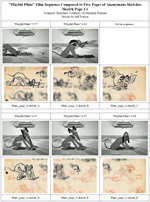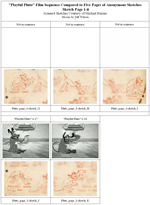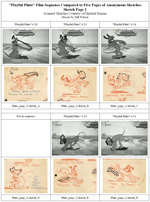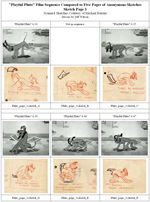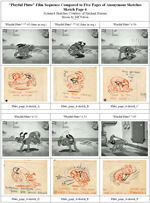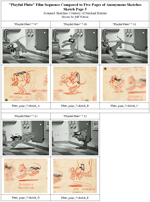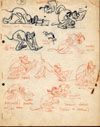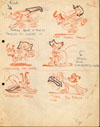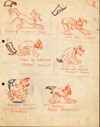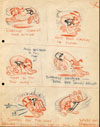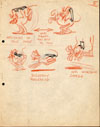
ESSAYS
The Flypaper Sequence Mystery
By Michael Barrier
An August 13, 2012, update: Gunnar Andreassen has written to me about the sketches below. For background on just why these sketches, and others like them, have proved to be such frustrating puzzles, go to the original post below and work your way forward. Here is what Gunnar wrote:
I just stumbled over some more drawings from this sequence, sold at auction by S/R Laboratories. They are offered as drawings by Norm Ferguson. This is the description:
ANIMATION THUMBNAIL DRAWINGS (3) from PLAYFUL PLUTO by NORM FERGUSON
#083
Pluto made his first appearance as an unnamed bloodhound in 1930’s “The Chain Gang," hot on the trail of escaped convict Mickey, no less, and he was animated by Norm Ferguson. One of Walt’s first great team of animators, Fergy was in charge of Pluto from that first appearance, but their partnership reached its pinnacle in what has become known as the classic flypaper sequence, universally recognized as a milestone in animation. These ultra rare drawings are Fergy’s original sketches, in which he worked out the complicated action. The sheets, as shown, are 12-field, 9-3/8 x 8-1/8”, and 9-3/8 x 6-3/8”, with notations in Fergy’s hand. They show their age with general wear and tanning and corner pinholes, but are no less a treasure for all that. 1934.
Disney
$500-900
However, I'm not at all sure that these were made by Ferguson. Could they have been made by Webb Smith?
One complication here is that S/R Laboratories also offered for auction what it described as "ANIMATION CONTINUITY SKETCHES AND LAYOUT DRAWINGS (6) from MICKEY’S PARROT" by Norm Ferguson. The draft does not show Ferguson animating on that film; the scenes in question are credited to Shamus Culhane. Bill Roberts directed the cartoon. So that could have some bearing on how seriously to take the attribution of the Playful Pluto sketches to Ferguson (as opposed to,say, another animator who was making sketches for his own reference). As always, your thought are welcome.

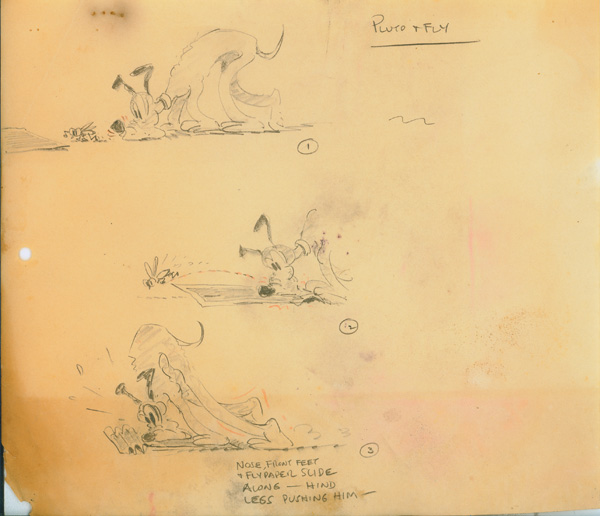
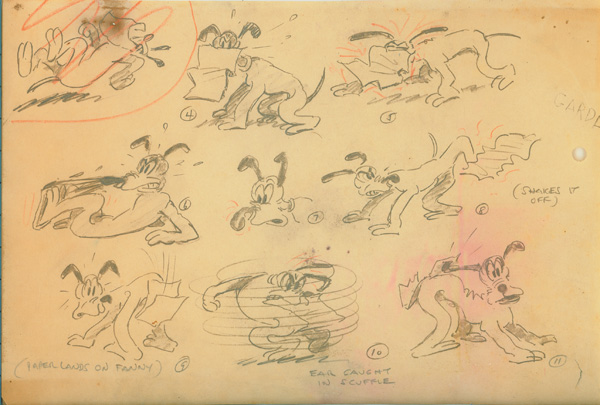
Gunnar has located other preliminary artwork for Playful Pluto, but no other pieces for the famous flypaper sequence, so I'll forgo posting them, at least for the time being.
April 19, 2009, update: Børge Ring, the renowned Danish animator, has weighed in on the long and still unresolved controversy about the authorship of what appear to be preliminary sketches for Norm Ferguson's famous flypaper sequence in the 1934 Disney cartoon Playful Pluto. (To go to the original posting, which includes scans of the sketches themselves, click on this link.) Børge offers a persuasive explanation of the role the sketches played and some new information about his role in uncovering them. He writes:
Ferguson's thumbnails for his flypaper sequence fired an enormous debate about their authenticity some time ago."They don't look like Fergy ruffs." That is correct. I think they look like what I am sure they are: an animator's final nailed-down shopping list before he takes off.
They look less like anything else.
I happened upon the thumbnails on Google internet, lost my breath and instantly mailed the place of the find to Fellow Fergy Fan John Canemaker. Twenty minutes later a breathless mail came back: "They are gorgeous." Divulging the find turned your blog site into a theatre of war among "the best brains" and a few grafologists with levelheaded intervention from the blog owner. Years later a man named [Ray] Kosarin confirmed my rights to believe what I wanted to believe.
Børge's thoughts are consistent with the ideas advanced earlier by Jeff Watson and John Canemaker, and, for now, at least, I'm content with the identification of the drawings as Ferguson's.
June 11, 2007, update: The original posting of this page in May produced only a few responses, but all of them interesting—and none of them offering definitive answers to the questions of who made the sketches for the flypaper sequence in Playful Pluto, and what purpose they served. There was, however, widespread doubt that Norm Ferguson drew the sketches as preparation for his landmark animation of the sequence.
J. B. Kaufman, co-author of several books on the Disney cartoons, most recently Walt Disney's Silly Symphonies, wrote: "I'm on very thin ice here, but I really have a strong feeling that the artist wasn't Ferguson. It's a gut feeling, but I just don't think the Pluto in these sketches looks like Ferguson's version of Pluto. It seems to me that a number of animators drew a Pluto that looks similar to this one, especially in 1931-32 but even as late as some of the scenes in Playful Pluto. But it seems to me that when Ferguson takes over the character, he has a distinctly different look a rounder face, for one thing."
Mark Kausler, a veteran animator who is better than anyone else I know at identifying the work of individual "golden age" animators, suggested that the drawings were Webb Smith's but that the captions were in Walt Disney's hand-lettering. "The drawings don't look like Norm Ferguson's at all, not even his scribbly roughs."
Mark Mayerson, another veteran animator and discerning student of classic animation, expressed similar doubts, at greater length:
I would not pretend to be an authority regarding this, but I don't believe that these drawings are by Ferguson. They appear to me to be either story sketches or preliminary character layouts. The argument against them being character layouts is that they're not separate, pegged drawings that an animator could place down on the board and use or adapt. However, I have no idea what the state of character layouts was in 1934.
I find the transition on page 2 of the flypaper being stuck to the ear and then being stuck to the back leg to be clumsy. It's not believable from an animator's standpoint. I'm away from home and don't have access to the cartoon, but I don't recall that transition being used in the final animation. There's nothing that clumsy in Ferguson's animation.
The clumsiness on page 2 is one reason I vote against the drawings being Ferguson's. Fergy's drawings tend to emphasize exploration of line of action and rhythm over the delineation of forms. These drawings are rather stodgy with regard to forms and line of action and I don't believe that Fergy would have settled for panels 2 and 3 on page 2.
I would like to see some of Smith's sketches at Disney, as opposed to his newspaper work, but I think it's more likely that the drawings are by Smith or a third party than by Ferguson.
Jeff Watson, by contrast, sees Ferguson's hand at work: "My judgment now is that the sketches are Ferguson's as he was refining the key/story-telling poses before developing extreme and break-down poses (if he worked that way in the mid-thirties). The most dramatic difference between the sketches and the final film is the shift of the sequence of the first two sketches (A and B) on page 4 to immediately after the sequence of the next 3 sketches (C, D, and E) on page 4—otherwise, much of the sequence occurs as in the sketches."
Jeff reached that conclusion as he created mosaics aligning the mystery sketches with frames from the finished film. He commented after completing the mosaics:
I'm more convinced the sketches are near-final story-telling poses before timing and rough animation began. The closeness of the sketch poses to the film, the film-pose deviations from sketches, and the dropping of other sketches from the sequence all indicate a post-story-development, pre-animation point in time for these particular sketches.
Something that does make me pause is the use of black and red pencil: in pages 2-5, black is only used for the flypaper, some notations, and effects; in page 1, the black pencil is used on the finished first pose and other early poses, with a switch to red pencil only on poses that are not closely related to or not in the sequence. It might be that page 1 contains earlier developed story-telling poses, only a couple of which actually made it to the film, while pages 2-5 were the near-final poses I noted above.
John Canemaker suggests that "the overdrawing of black on the flypaper in most of the sketches could have been for clarity as Fergy planned out the shapes and forces for animating both the dog's body and the prop." John remains convinced of Ferguson's authorship: "As I've said before, I think Fergy's 'poor' (sloppy?) draftsmanship is seen on the five pages in these pre-animation thumbnails. When he began to animate, his other drawing style—the elegant, calligraphic, detail-free line—appears, and Fergy becomes like an amphibian's movements that are ungainly on land but beautiful underwater."
It seems at least possible that the red and the black are evidence of two hands at work, perhaps the director's (Burt Gillett) and the animator's (Norm Ferguson). I don't think we're close yet to a definitive answer as to who drew the sketches; but judge for yourselves. Here are thumbnails of each of Jeff Watson's mosaics comparing sketches and film; clicking on each one will bring up the full-size mosaic. (The first page of the sketches has been divided between two mosaics.)
I mentioned the outline for an early version of this story, then called "Spring Cleaning," in my May 30 update just below. David Gerstein has written with some more information:
You state that "there was no copy of the outline in the Walt Disney Archives when I was looking for such things in the mid-1990s, but, fortunately, I do have a copy, courtesy of the late Ben Sharpsteen. [...] The outline [is] for a story then called 'Spring Cleaning'..." At the Disney ARL [Animation Research Library] (where animation preproduction material seems mostly to have migrated around 2000), the "Spring Cleaning" outline is stored with the unproduced shorts material, in the folder for "Pluto's Pal Bobo," where I discovered it when researching Mickey and the Gang in 2005. ... From what I was able to gauge, the story crew seem to have subsequently split the concept of a spring cleaning cartoon into two shorts— the autumn cleaning cartoon Playful Pluto , and the now-unrelated spring cleaning cartoon that languished in development, finally becoming a planned Bobo [the elephant character in Mickey's Elephant] sequel in 1938. As such it kept the "Spring Cleaning" title for awhile before becoming "Pluto's Pal Bobo."
And finally, just to complicate matters, here are some circa-1935 sketches that Frank Thomas and Ollie Johnston, in their book Too Funny for Words: Disney's Greatest Sight Gags, identify as Webb Smith's (an identification I'm sure is correct, based on my own examination of the "story sketch books" for the Disney shorts of the mid-thirties). My initial thought was that the mystery sketches for the flypaper sequence might be by Smith, and I'm still not entirely sure they aren't.
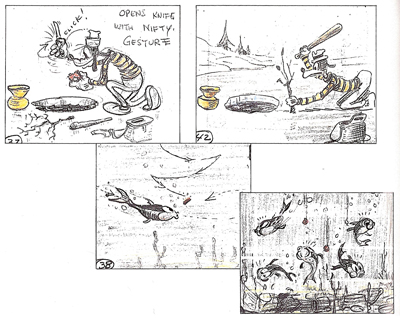

May 30, 2007, update: J. B. Kaufman has made the excellent suggestion that the gag outline for this cartoon might be of use in determining the nature of the mystery sketches. There was no copy of the outline in the Walt Disney Archives when I was looking for such things in the mid-1990s, but, fortunately, I do have a copy, courtesy of the late Ben Sharpsteen. There's no story man's name on the sheet, which calls for gags to be "sketched up and ready to hand in" by Friday, August 4, 1933. The outline, for a story then called "Spring Cleaning," includes this paragraph about the flypaper sequence: "Then we expect to use a build-up gag of Pluto. He gets mixed up with a sheet of fly-paper in trying to catch a fly, and we'll carry this business thru, showing the various ways in which Pluto gets twisted up with the fly-paper, possibly working it into a part where he upsets a whole stack of fly-paper. We could use suggestions of Pluto getting stuck to various objects about the house."
Such outlines were usually distributed some time after work on a story had begun—the writers were mainly looking for "business" that would add to the comic density of a cartoon—so it's quite likely that the episode Walt described, when he stirred Webb Smith to generate "a whole wall full of things," occurred before the outline circulated. But could the mystery sketches have been submitted as gag suggestions, as J. B. Kaufman proposes? And if so, might they have been submitted by an animator or assistant? That could account for the animation-related notations; it could also account for the discrepancy between how Pluto is drawn in the sketches and how he appears in the cartoon, and on Norm Ferguson's model sheet. It's easy to imagine some young animator looking at that "wall full of things," spotting the gag drawings that lent themselves to animation, and assembling them in sketches for a sequence whose potential Ferguson exploited brilliantly.
The original May 28, 2007, posting: There may be no animation sequence more famous than the flypaper sequence in the 1934 Disney cartoon Playful Pluto. It was in that cartoon that Norman Ferguson animated Pluto with a psychological realism that was new to American studio animation. It's Pluto's frustration and irritation, as he struggles to free himself from a sheet of flypaper, that defines the sequence, more than the gags that make it up.
Ferguson's colleagues at the Disney studio knew immediately that his animation was a breakthrough, as did Walt himself. In August 1934, when the Toledo (Ohio) Museum of Art was about to put up an exhibition of Disney artwork, a museum official asked Walt for a list of the cartoons he thought were the studio's best. Walt singled out Playful Pluto for praise: "I consider it to be of extraordinary merit."
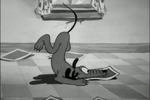
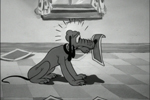
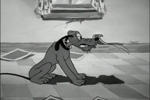
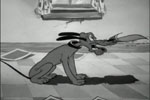
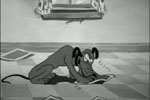
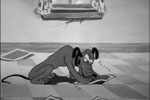
Before the flypaper sequence existed as animation, though, it existed as sketches that Walt described this way in his 1956 interview with Pete Martin:
I used to work very hard on gag situations when I had time. And I set up a special group of fellows just to work on situations. Like there was one boy with me, he died some years ago, but he was a wonderful old newspaper cartoonist. Had a wonderful personality and a very lovable fellow. He was not a practical artist. He was just an out-and-out cartoonist. But his name was Webb Smith ... he was from an Arizona paper. He came to me with this big cigar and some of these little gags and he would always laugh when he told about his gags and things. And I just put him in to think of ideas. So I used to throw Webb a situation. I'd say—like I had one there I wanted to do. I'd think a basic situation. I'd throw it to him. What could happen. Pluto was always getting mixed up in things. So I went to Webb one time. I said, "Look, Webb, Pluto's always going along smelling. He never looks where's going, you know?" So I said, "What would happen if Pluto happened to be smelling along and run into flypaper, you see?" So I just left Webb and walked away. I came back in two days and here was a whole wall full of things that would happen to that dog if he got mixed up with flypaper, see? So the process would be of sitting down with that, taking some of those ideas, copying continuity, see? Well, out of that came a thing that was a classic in its day that was known even in the industry, known as the flypaper sequence. It was this thing of Pluto getting into this flypaper. And this poor pup, he didn't know what happened, you know? He tried to blow it off, couldn't blow it off. He tried to get it off his nose. It was the old burlesque routine. So when he'd start to go it was on here, you see? And put it down again. He tried to pull it off with his hind leg and then he had it on both. You see? And then he started going around. He got it stuck from his head to his fanny, you know? And he'd pull and pull and pull and when he came around it wrapped clear around his face.
Walt's enthusiasm makes me want to see Smith's sketches—but at the time he made them, the Disney studio wasn't saving such things.
In the early 1930s, the studio began compiling what came to be called "story sketch books" for each cartoon, made up of sketches representing many if not all of the cartoon's scenes. Typically, too, the books included a draft, a scene-by-scene breakdown with animators' credits. I'm not sure what purpose the sketch books served, although they may have been ready references at a time when looking at the actual cartoon was not as easy as popping a DVD into computer tray.
By the late 1930s many drawings in the story sketch books were recognizable as real story sketches—that is, their authors were concerned with putting a gag across, not with how it would be staged. Earlier books, though, like the one for Playful Pluto, are made up mostly or entirely of preliminary layout drawings—pencil sketches of varying size, some of them on sheets as large as 6 1/2 inches by 8 inches. The book for Playful Pluto includes no drawings of any kind for the flypaper sequence past the point at which Pluto's nose gets stuck to the flypaper.
The natural conclusion is that Smith's sketches were discarded, along with other early story sketches; but could they have survived?
Five sheets of drawings for Playful Pluto have turned up recently in the hands of a private collector. That collector prefers to remain anonymous, but he has provided the scans that accompany this essay. You can view a scan of each sheet by clicking the thumbnails below:
It was common in the middle thirties for gag men, at Disney's and other studios, to use sheets of animation paper, sometimes filling a sheet with a half dozen or more sketches illustrating a gag. It was only later that cartoon writers routinely made single drawings on smaller sheets of paper and pinned them on a board. So these five sheets of drawings could be story sketches—but are they? John Canemaker, who was instrumental in calling them to my attention and in obtaining the scans, suggests that the drawings are not by Webb Smith, but by Norm Ferguson::
I tend toward believing that the five pages of Pluto are Fergy's thumbnails used to develop the animation for the sequence from Smith's initial gags. These preparatory drawings contain notes on timing and technique—i.e., "stretch nose" and "also hesitates in this pose," and a general animator's feeling for staging and working out how to segue the gags so they flow one into the other (as they do in the film). There is also the attention paid to the thinking process of the character and Pluto's emotional state ("turns to audience happy;" "Sits on it—expression changes"; "licks paw—happy"). Also, Pluto looks out at the audience in Fergy's oft-used version of Chaplin's eye contact communication. To me the action and the character found in the animation is all there in these sketches. Everything but the timing, of course. If Smith had this all worked out, what does that say about the vaunted abilities of Fergy as actor, as developer of personality traits in characters, and his fame for his investing Pluto with a rudimentary brain and emotional life? In your own words, from Hollywood Cartoons, "Smith's idiosyncratic drawings did not translate easily into animation." In Diane Miller's book, she describes "a wall covered with [Playful Pluto] sketches of things that could happen to Pluto . . ." I think Fergy selected bits of business from Smith's wall-full of ideas; he organized and built them in a dramatic order, distilled them and added details on the five sheets of thumbnails.
That's at least as plausible as my suggestion that these might be Smith's drawings, especially considering that Smith's work from his newspaper-cartoonist days (see the sample just below) is very much in a George Herriman style. I've seen story sketches I believe are Smith's that don't have that Herriman look, but I can't say that they much resemble the drawings of Pluto on these five sheets.
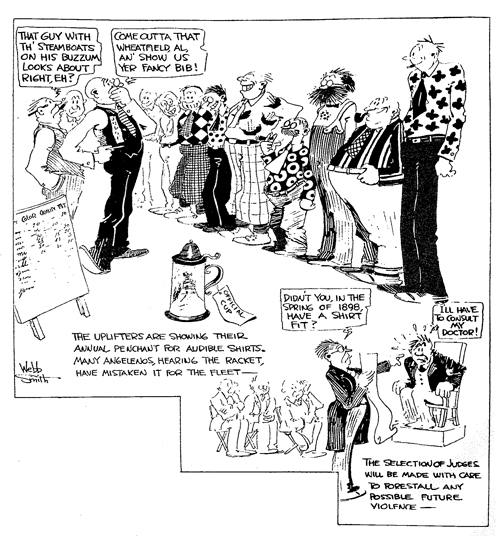
Then again, the drawings also don't look much like Fergy's more finished drawings from the same period; see, for example, his Pluto model sheet on page 96 of my book Hollywood Cartoons. The drawings' current owner is skeptical about Ferguson's authorship: "I somehow doubt that they are Fergy's; as you can see, the lines are fairly clean. When exploring ideas for acting and movement he probably drew in a looser manner." (For examples of just how loosely Ferguson often drew, click here.)
There is a third possibility, that these drawings were made by neither Smith nor Ferguson, but by someone else, perhaps another animator who was scrutinizing Ferguson's animation on a Moviola, analyzing what he did, and making "notes" in the form of drawings.
I'd prefer to think the drawings are by Smith or Ferguson, but it will probably take some close examination by Hollywood animation's greatest students before any sort of consensus emerges. I look forward to hearing what they think.
[Playful Pluto is part of the DVD set Walt Disney Treasures: Mickey Mouse in Black and White, Volume 2.]
[Posted May 28, 2007; updated May 30 and June 11, 2007, and April 19, 2009.]
